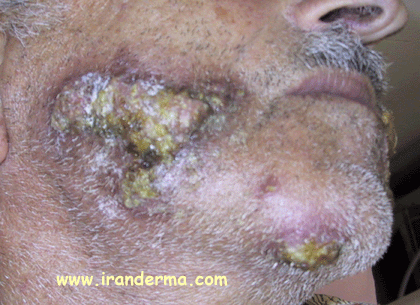July 2003
Designed by;
O. Zargari , MD
Razi Hospital, Rasht, Iran
A 59-year-old farmer man presented with a long time history for aymptomatic purulent plaques on his face which was unresponsive to several courses of antibiotic therapy.
What's your diagnosis and differentials?

Dx: Tinea Barbae
Tinea
Barbae is a dermatophytic infection of the beard and moustache areas of
the face with invasion of coarse hairs. It is thus a disease of the adult
male and commonly affects farm workers.The
animal species T.verrucosum and T.mentagrophytes are
responsible for the great majority of cases.
The
pathogenesis of T. Barbae is similar to T. Capitis and in the case of
infection with zoophilic species; the clinical picture is a highly
inflammatory pustular folliculitis often showing all the features of a
kerion. Indeed, kerion is the most severe reaction in dermatophytic
infections, usually caused by zoophilic species and characterized by one
or multiple inflammatory mass with discharging and sometimes sinus
formation and even mycetoma-like grains.
In
this case, routine KOH examination was negative, but culture proved a
dermatophytic infection with T.verrucosum and treatment with
griseofulvin successfully controlled the condition.
In
the differential diagnosis bacterial folliculitis, acne, actinomycosis,
lupus vulgaris and leishmaniasis should be considered.
Note:
This picture is not uncommon in our area in Middle East and not
surprizingly the correct responders to the quiz were all from this area!
The most common answer has been send for this quiz was actinomycosis,
followed by lupus vulgaris, sporotrichosis, leishmaniasis, blastomycosis,
syphilis, and furunculosis.